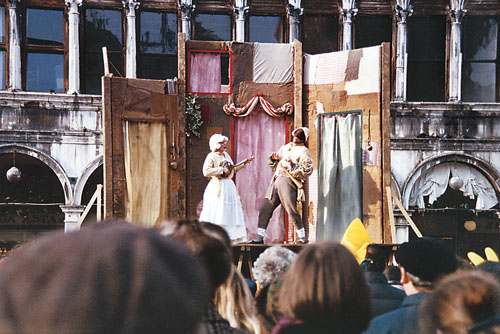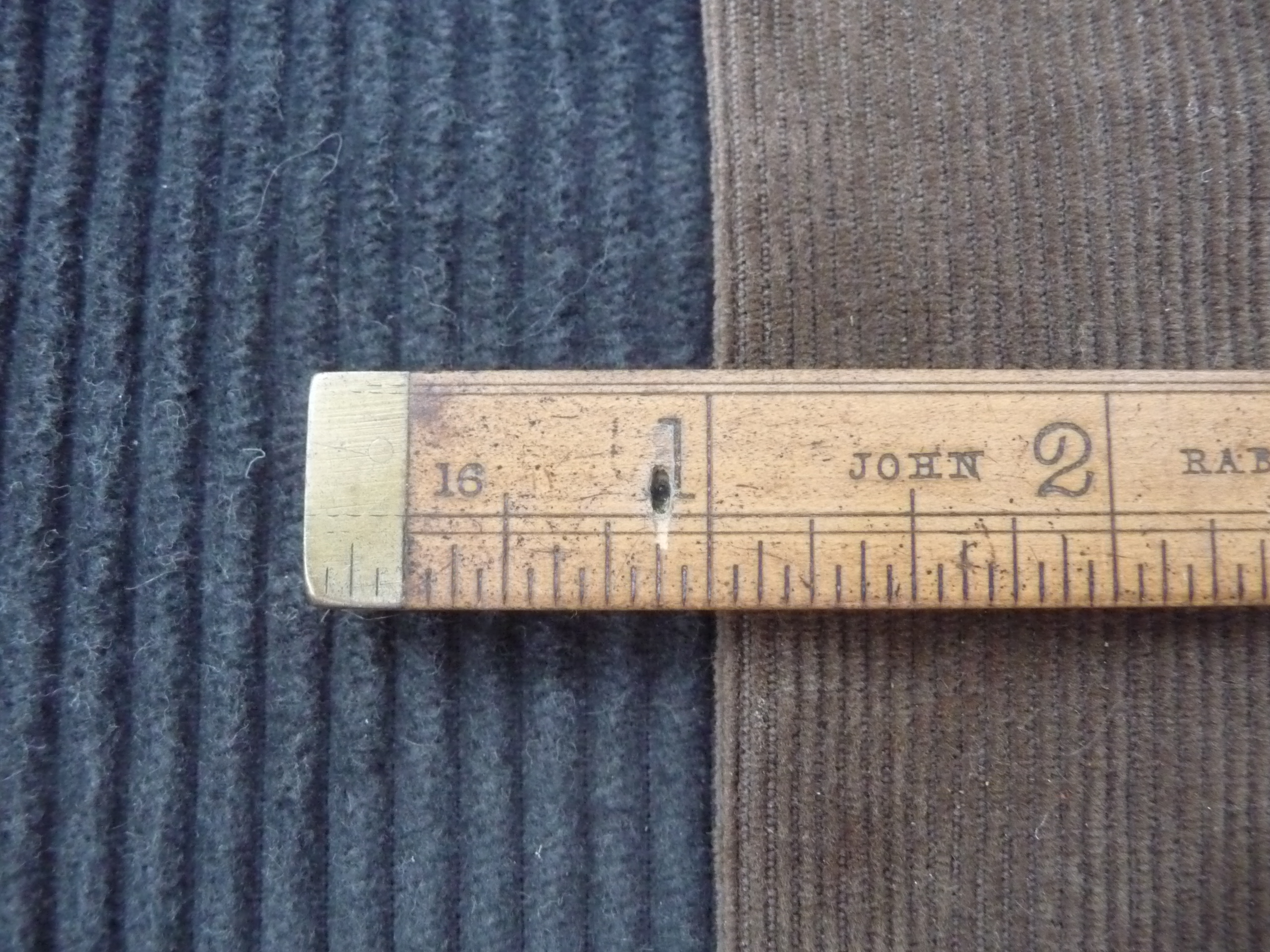|
Sandrone
Sandrone (Sandróun in Modenese dialect) is the traditional mask and character of the Commedia dell'arte representing the city of Modena. Origin Sandrone, is represented as a peasant who is crude, clever, and cunning. He is seen as the spokesman of a humble people who are ill-treated, eternally hungry, and always using tricks to make ends meet. The character of his wife, Pulonia, appears in 1840, soon followed by a son Sgorghiguelo. The three form what is known as the Pavironica family. Initially, these characters were presented as puppets. Beginning in the late 19th century the three were represented by male actors known as "the Pulonia". Dressed in a style of clothing popular around 1700, Sandrone sports a corduroy jacket, short corduroy pants, red and white cross-striped socks, a floral embroidered vest, and sturdy farmer's boots. He also wears a wig with long hair, partly covered by a white wool nightcap ending in a tassel. His son (Sgorghiguelo) wears a wig and a redd ... [...More Info...] [...Related Items...] OR: [Wikipedia] [Google] [Baidu] |
Commedia Dell'arte
(; ; ) was an early form of professional theatre, originating from Italian theatre, that was popular throughout Europe between the 16th and 18th centuries. It was formerly called Italian comedy in English and is also known as , , and . Characterized by masked "types", was responsible for the rise of actresses such as Isabella Andreini and improvised performances based on sketches or scenarios. A , such as ''The Tooth Puller'', is both scripted and improvised. Characters' entrances and exits are scripted. A special characteristic of is the , a joke or "something foolish or witty", usually well known to the performers and to some extent a scripted routine. Another characteristic of is pantomime, which is mostly used by the character Arlecchino, now better known as Harlequin. The characters of the usually represent fixed social types and stock characters, such as foolish old men, devious servants, or military officers full of false bravado. The characters are exaggerated " ... [...More Info...] [...Related Items...] OR: [Wikipedia] [Google] [Baidu] |
Modena
Modena (, , ; egl, label=Emilian language#Dialects, Modenese, Mòdna ; ett, Mutna; la, Mutina) is a city and ''comune'' (municipality) on the south side of the Po Valley, in the Province of Modena in the Emilia-Romagna region of northern Italy. A town, and seat of an archbishop, it is known for its car industry since the factories of the famous Italian upper-class sports car makers Ferrari, De Tomaso, Lamborghini, Pagani (automobile), Pagani and Maserati are, or were, located here and all, except Lamborghini, have headquarters in the city or nearby. One of Ferrari's cars, the Ferrari 360, 360 Modena, was named after the town itself. Ferrari's production plant and Formula One team Scuderia Ferrari are based in Maranello south of the city. The University of Modena, founded in 1175 and expanded by Francesco II d'Este in 1686, focuses on economics, medicine and law, and is the second oldest :wikt:athenaeum, athenaeum in Italy. Italian military officers are trained at the Milit ... [...More Info...] [...Related Items...] OR: [Wikipedia] [Google] [Baidu] |
Peasant
A peasant is a pre-industrial agricultural laborer or a farmer with limited land-ownership, especially one living in the Middle Ages under feudalism and paying rent, tax, fees, or services to a landlord. In Europe, three classes of peasants existed: slave, serf, and free tenant. Peasants might hold title to land either in fee simple or by any of several forms of land tenure, among them socage, quit-rent, leasehold, and copyhold. In some contexts, "peasant" has a pejorative meaning, even when referring to farm laborers. As early as in 13th-century Germany, the concept of "peasant" could imply "rustic" as well as "robber", as the English term villain/villein. In 21st-century English, the word "peasant" can mean "an ignorant, rude, or unsophisticated person". The word rose to renewed popularity in the 1940s–1960s as a collective term, often referring to rural populations of developing countries in general, as the "semantic successor to 'native', incorporating all its conde ... [...More Info...] [...Related Items...] OR: [Wikipedia] [Google] [Baidu] |
Puppets
A puppet is an object, often resembling a human, animal or mythical figure, that is animated or manipulated by a person called a puppeteer. The puppeteer uses movements of their hands, arms, or control devices such as rods or strings to move the body, head, limbs, and in some cases the mouth and eyes of the puppet. The puppeteer often speaks in the voice of the character of the puppet, and then synchronizes the movements of the puppet's mouth with this spoken part. The actions, gestures and spoken parts acted out by the puppeteer with the puppet are typically used in storytelling. Puppetry is a very ancient form of theatre which dates back to the 5th century BC in Ancient Greece. There are many different varieties of puppets, and they are made from a wide range of materials, depending on their form and intended use. They range from very simple in construction and operation to very complex. Two simple types of puppets are the finger puppet, which is a tiny puppet that fits ... [...More Info...] [...Related Items...] OR: [Wikipedia] [Google] [Baidu] |
Corduroy
Corduroy is a textile with a distinctively raised "cord" or wale texture. Modern corduroy is most commonly composed of tufted cords, sometimes exhibiting a channel (bare to the base fabric) between them. Both velvet and corduroy derive from fustian fabric. Corduroy looks as if it is made from multiple cords laid parallel to each other. Etymology The word ''corduroy'' is from ''cord'' and ''duroy'', a coarse woollen cloth made in England in the 18th century. Although the origin of ''duroy'' is not attested and although its likely meaning is ''du roi'' (''of the King''), it does not follow that the full phrase ''corde du roi'' derives from ''the cord of the King''. This is probably a false etymology. Variations Corduroy is made by weaving extra sets of fibre into the base fabric to form vertical ridges called ''wales''. The wales are built so that clear lines can be seen when they are cut into pile. Corduroy is considered a durable cloth, and is found in the construction of tro ... [...More Info...] [...Related Items...] OR: [Wikipedia] [Google] [Baidu] |
Carnival
Carnival is a Catholic Christian festive season that occurs before the liturgical season of Lent. The main events typically occur during February or early March, during the period historically known as Shrovetide (or Pre-Lent). Carnival typically involves public celebrations, including events such as parades, public street parties and other entertainments, combining some elements of a circus. Elaborate costumes and masks allow people to set aside their everyday individuality and experience a heightened sense of social unity.Bakhtin, Mikhail. 1984. ''Rabelais and his world''. Translated by H. Iswolsky. Bloomington: Indiana University Press. Original edition, ''Tvorchestvo Fransua Rable i narodnaia kul'tura srednevekov'ia i Renessansa'', 1965. Participants often indulge in excessive consumption of alcohol, meat, and other foods that will be forgone during upcoming Lent. Traditionally, butter, milk, and other animal products were not consumed "excessively", rather, their stoc ... [...More Info...] [...Related Items...] OR: [Wikipedia] [Google] [Baidu] |
Lent
Lent ( la, Quadragesima, 'Fortieth') is a solemn religious observance in the liturgical calendar commemorating the 40 days Jesus spent fasting in the desert and enduring temptation by Satan, according to the Gospels of Matthew, Mark and Luke, before beginning his public ministry. Lent is observed in the Anglican, Eastern Orthodox, Lutheran, Methodist, Moravian, Oriental Orthodox, Persian, United Protestant and Roman Catholic traditions. Some Anabaptist, Baptist, Reformed (including certain Continental Reformed, Presbyterian and Congregationalist churches), and nondenominational Christian churches also observe Lent, although many churches in these traditions do not. Which days are enumerated as being part of Lent differs between denominations (see below), although in all of them Lent is described as lasting for a total duration of 40 days. In Lent-observing Western Churches, Lent begins on Ash Wednesday and ends approximately six weeks later; depending on the Christian ... [...More Info...] [...Related Items...] OR: [Wikipedia] [Google] [Baidu] |
Palace
A palace is a grand residence, especially a royal residence, or the home of a head of state or some other high-ranking dignitary, such as a bishop or archbishop. The word is derived from the Latin name palātium, for Palatine Hill in Rome which housed the Roman Empire, Imperial residences. Most European languages have a version of the term (''palais'', ''palazzo'', ''palacio'', etc.), and many use it for a wider range of buildings than English. In many parts of Europe, the equivalent term is also applied to large private houses in cities, especially of the aristocracy; often the term for a large country house is different. Many historic palaces are now put to other uses such as parliaments, museums, hotels, or office buildings. The word is also sometimes used to describe a lavishly ornate building used for public entertainment or exhibitions such as a movie palace. A palace is distinguished from a castle while the latter clearly is fortified or has the style of a fortification ... [...More Info...] [...Related Items...] OR: [Wikipedia] [Google] [Baidu] |






